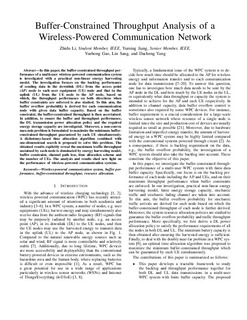| dc.contributor.author | Li, Zhidu | |
| dc.contributor.author | Jiang, Yuming | |
| dc.contributor.author | Gao, Yuehong | |
| dc.contributor.author | Sang, Lin | |
| dc.contributor.author | Yang, Dacheng | |
| dc.date.accessioned | 2019-09-03T06:52:29Z | |
| dc.date.available | 2019-09-03T06:52:29Z | |
| dc.date.created | 2019-01-17T09:53:40Z | |
| dc.date.issued | 2019 | |
| dc.identifier.citation | IEEE Journal on Selected Areas in Communications. 2019, 37 (2), 283-297. | nb_NO |
| dc.identifier.issn | 0733-8716 | |
| dc.identifier.uri | http://hdl.handle.net/11250/2612123 | |
| dc.description.abstract | In this paper, the buffer-constrained throughput performance of a multi-user wireless-powered communication (WPC) system is investigated, where energy harvesting follows a non-linear model. The investigation focuses on the buffer overflow performance of sending data in the downlink (DL) from the access point (AP) node to each user equipment (UE) node and that in the uplink from each UE node to the AP node, based on which the throughput performance on both directions when a buffer constraint is enforced is studied. Specifically, the buffer overflow probability at each node is analyzed, based on which the buffer-constrained throughput is studied. In addition, to ensure the throughput performance under the buffer constraint, the DL transmission power allocation policy and the required energy storage capacity at each UE are investigated. Also, the optimal channel time allocation policy is studied with the objective of maximizing the minimum buffer-constrained throughput guaranteed to each UE at the same time. To this aim, an optimization problem is first formulated and then a dichotomy-based time allocation algorithm combined with a one-dimensional search is proposed to solve this problem. The analysis and results, explicitly relating the throughput to the buffer constraint in addition to WPC characteristics, shed new light on the design and performance analysis of WPC systems. | nb_NO |
| dc.language.iso | eng | nb_NO |
| dc.publisher | IEEE | nb_NO |
| dc.title | On Buffer-Constrained Throughput of a Wireless-Powered Communication System | nb_NO |
| dc.type | Journal article | nb_NO |
| dc.type | Peer reviewed | nb_NO |
| dc.description.version | acceptedVersion | nb_NO |
| dc.source.pagenumber | 283-297 | nb_NO |
| dc.source.volume | 37 | nb_NO |
| dc.source.journal | IEEE Journal on Selected Areas in Communications | nb_NO |
| dc.source.issue | 2 | nb_NO |
| dc.identifier.doi | http://dx.doi.org/10.1109/JSAC.2018.2872374 | |
| dc.identifier.cristin | 1658921 | |
| dc.description.localcode | © 2019 IEEE. Personal use of this material is permitted. Permission from IEEE must be obtained for all other uses, in any current or future media, including reprinting/republishing this material for advertising or promotional purposes, creating new collective works, for resale or redistribution to servers or lists, or reuse of any copyrighted component of this work in other works. | nb_NO |
| cristin.unitcode | 194,63,30,0 | |
| cristin.unitname | Institutt for informasjonssikkerhet og kommunikasjonsteknologi | |
| cristin.ispublished | true | |
| cristin.fulltext | preprint | |
| cristin.qualitycode | 1 | |
